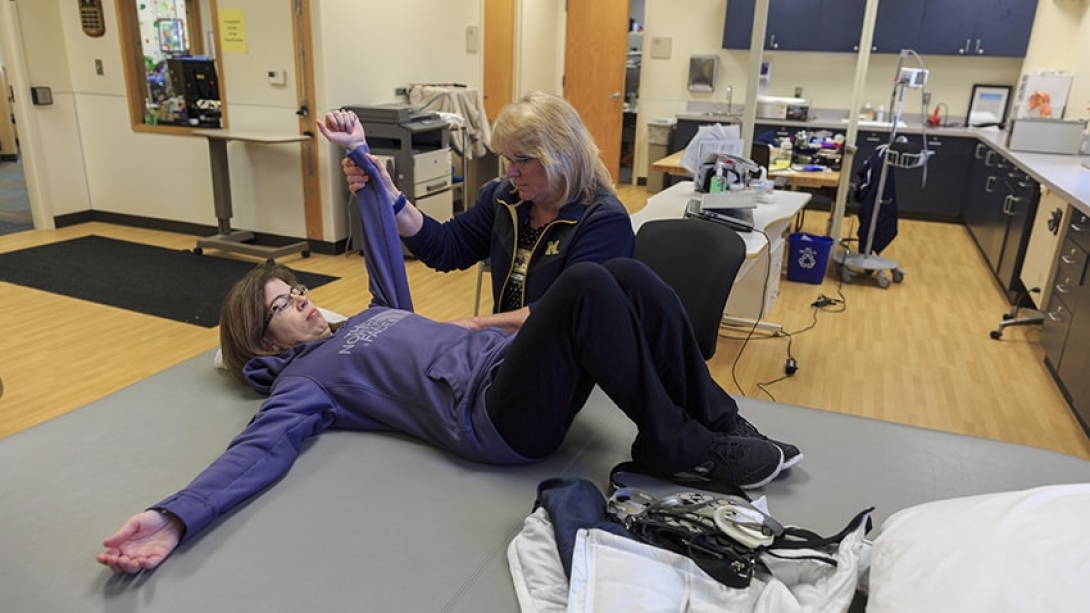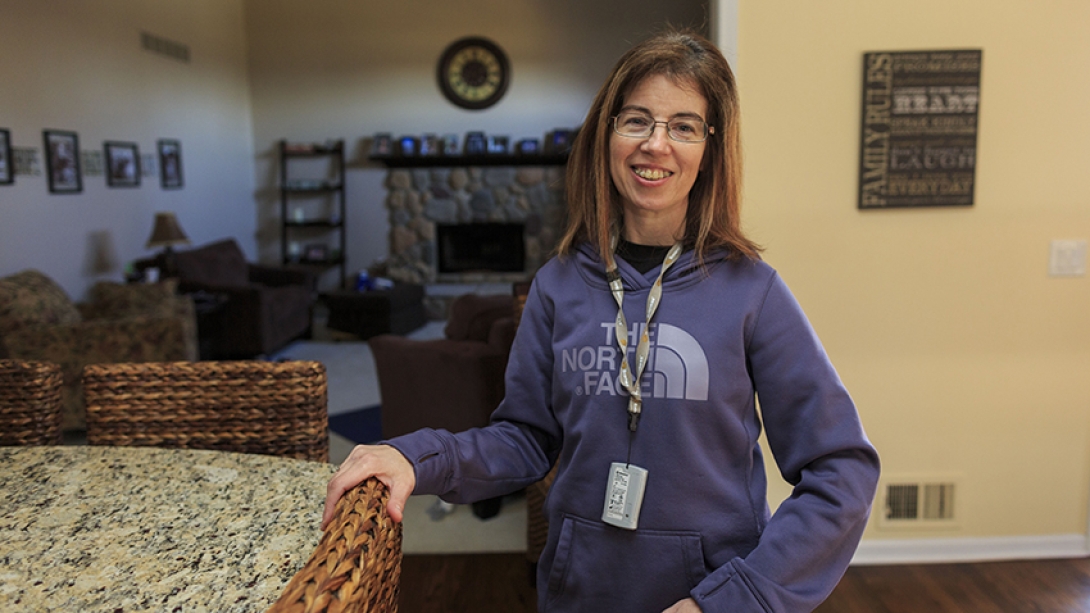Four years after her stroke, a mother works hard to strengthen her mind and body. She shares personal advice based on that journey.
7:00 AM
Author |
Barbara Wiley had thought she was a healthy 41-year-old mother of two the day she had her stroke.
ASK ALEXA: Add the Michigan Medicine News Break to Your Flash Briefing
The morning of October 17, 2013, started with her usual vegetarian breakfast and her usual daily run. She saw her children off to school and later drove an hour south of her home in Canton, Michigan, to pick up a table she had found on Craigslist.
While loading the table into her car, Wiley began to feel nauseated. Sensing that something was wrong, the table's seller suggested they call 911.
"I was adamant that I did not want to take an ambulance away from someone who really needed it," recalls Wiley, agreeing instead to call her husband to come get her.
The seller, meanwhile, used her own phone to call 911, relaying questions from the 911 operator to Wiley and confirming her answers with Wiley's husband.
"As that was happening I told them I felt a burst behind my eye," Wiley recalls. "I wasn't that worried until I heard her repeat it to the 911 operator. I remember thinking, 'That doesn't sound good.'"
Wiley was rushed to the nearby hospital in Tecumseh, Michigan, then airlifted by Michigan Medicine's Survival Flight to Ann Arbor.
The diagnosis: a rare type of stroke.
Rare complication and major surgery
Wiley was told she had suffered a stroke caused by an arteriovenous malformation (AVM) in her brain. An AVM is a tangled cluster of vessels that form at a point where an artery and a vein come together.
MORE FROM MICHIGAN: Sign up for our weekly newsletter
Typically, a system of capillaries exists at that point. Without capillaries to regulate the speed and volume of circulating blood, however, blood flowing at very high pressure can rupture an AVM.
That was the sensation Wiley felt behind her eye.
Brain AVMs are rare, occurring in less than 1 percent of the population, and usually produce no symptoms until a serious complication such as stroke occurs.
Their cause is unknown, but doctors believe that a congenital defect was responsible for the AVM in Wiley's brain.
Wiley's AVM and a portion of her skull were removed during a 12-hour surgery.
She was hospitalized until December 2013 and was then transferred to a subacute rehabilitation facility until March 2014. A second procedure to restore the missing portion of her skull was scheduled for April but delayed until August of that year due to further complications.

A long rehabilitation journey
The stroke left Wiley with weakness and spasticity on her left side.
Soon after leaving the rehab facility, Michigan Medicine physical and occupational therapists began working with Wiley in her home. Later that year, she transitioned to outpatient therapy at Michigan Medicine's Canton Health Center.
One constant in Wiley's care has been her physical therapist, Hendrika Lietz, P.T., D.P.T., N.C.S.
"I've been with Barb since those early days in the ICU," says Lietz, noting that early efforts to help the 90-pound Wiley stand up required four people to assist. "She was tremendously weak then and had virtually no muscle control. She's made amazing progress since then."
The main goal of Wiley's physical therapy has been learning to walk again. Balance problems, instability in her left ankle and the inability to swing her left arm all make walking difficult.
Wiley's team has employed numerous strategies to retrain her body. For example, Lietz encourages Wiley to walk as fast as she can on a treadmill, which is thought to release a brain chemical that stimulates neurons to learn or relearn function.
Helping others and herself
Wiley's rehabilitation journey has also included participating in clinical research.
"Michigan Medicine is involved in a number of projects to develop and test new PT and OT tools to help stroke patients recover," says Lietz. "Several of the approaches we've tried with Barb utilize gaming technology to challenge her to use different body parts to complete tasks."
SEE ALSO: How Stroke Rehabilitation Helps Patients Recover 'Faster and Better'
Countless hours of occupational therapy have focused on helping Wiley adapt to using her left hand, despite having very little sensation in it.
"At first, my fingers wouldn't open," Wiley recalls. "I couldn't straighten my elbow, and my fist would hug my chest when I tried to walk."
Which is why she is working hard to relearn everyday tasks, such as holding objects. "Since I can't feel what I'm holding, I don't know how much pressure to grip with to keep from dropping things," Wiley says.
Wiley also suffered from 'left neglect,' a tendency to ignore or have trouble paying attention to things happening on the left side of her body. Thanks to therapeutic tools such as word searches and other puzzles, this consequence of Wiley's stroke has improved significantly.

Advice for stroke patients
Surviving a stroke has taught Wiley and her family countless lessons in trust, patience, determination and optimism.
Her advice to other stroke patients:
Don't expect a quick fix. While a stroke happens in an instant, recovery takes much, much longer. "At first I thought I would be completely recovered in a year," Wiley says. "I remember telling my daughter this would be a blip on the timeline of her life."
While her rehabilitation has proved to be far more than a blip, perseverance has paid off with significant progress.
She walks more easily today, thanks to a stabilizing ankle and foot orthotic and an electronic stimulation device worn on her leg. She has benefitted from Botox injections in her arms, hands, legs and feet. And for the foreseeable future, she plans to continue receiving outpatient physical and occupational therapy.
"Some people think that all of the recovery comes in the first six months to a year and after that there is no more benefit to rehabilitation," says Lietz. "But Barb is living proof that that's not true: every patient is different. Barb has made significant progress in her second and third years of rehab, including returning to driving.
"If she would have stopped at the end of year one, she wouldn't be where she is today."
Keep the faith. As months of recovery have stretched into years, Wiley admits she has often had thoughts of giving up on therapy. She relies on her faith in God to carry her through hard times. "I may think about quitting, but I don't do it!" she says.
Seek help and support from old friends and new. As Wiley has learned, not every friendship can withstand the road back from a stroke. But a core group of her true friends have stood by her and continue to celebrate her victories. Fellow stroke survivors are also a key source of support.
Because strokes usually strike people later in life, support groups tend to center on the experiences of older survivors. Although no young survivors' support groups operate in her area, Wiley relies on an active Facebook group of younger stroke survivors for tips, advice, exercises and emotional support.
Look for new ways to be active and recapture that "old me" feeling. Prior to her stroke, Wiley was an avid runner and cyclist and enjoyed rock climbing and kayaking. In addition to kayaking again with her family, an online connection with a fellow stroke survivor inspired her to try sled hockey — and to plan future outings for yoga, zip lining and rock climbing.
Another online group, Spokes Fighting Strokes, introduced Wiley to adaptive cycling. Both she and Lietz believe outdoor cycling is proving beneficial to her rehabilitation.
Call 911 immediately if you suspect a stroke. "I sometimes wonder what might have been different if I had not delayed that call," says Wiley. Even though the woman who witnessed Wiley's stroke was a stranger, she had the good sense to realize that the situation called for emergency assistance.
"I'm forever grateful to her," Wiley says. "Since that day we've kept in touch; she's even joined us for dinner at our house — at that table!"
Photos by Bryan McCullough

Explore a variety of health care news & stories by visiting the Health Lab home page for more articles.

Department of Communication at Michigan Medicine
Want top health & research news weekly? Sign up for Health Lab’s newsletters today!





